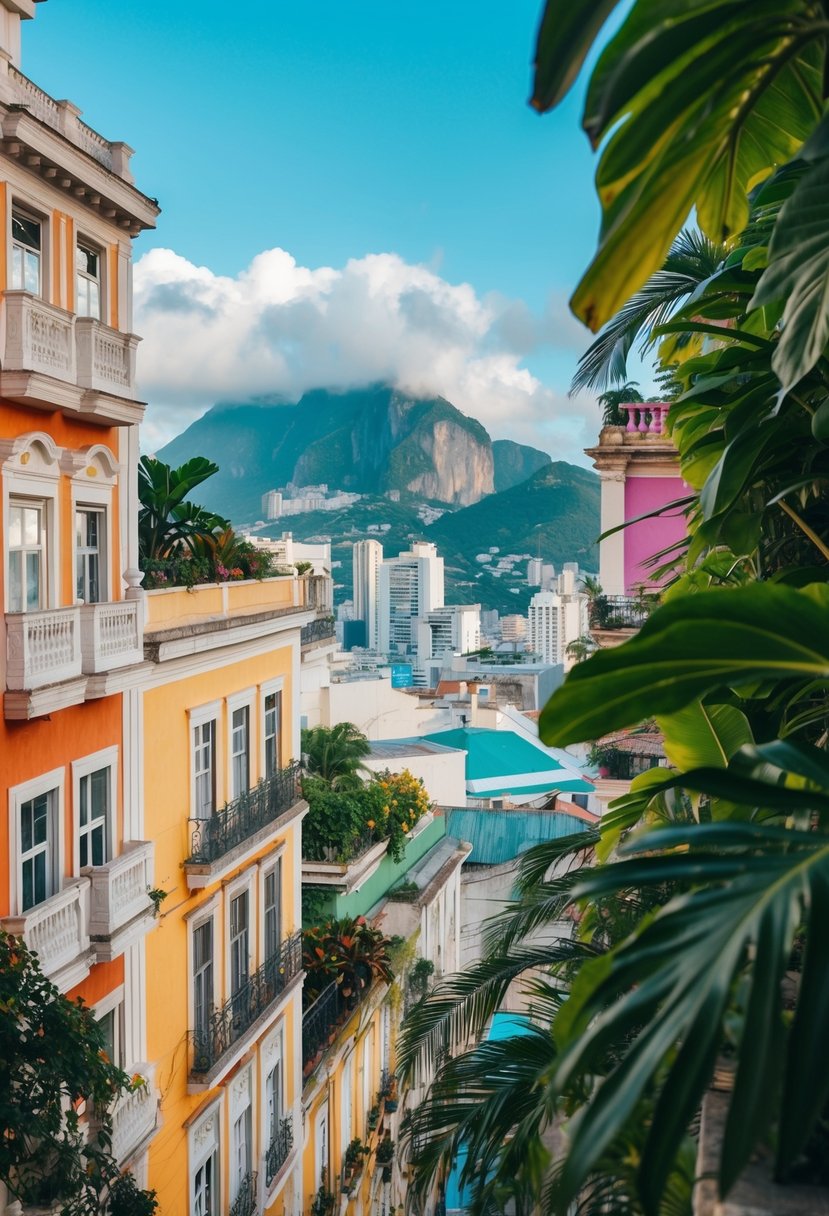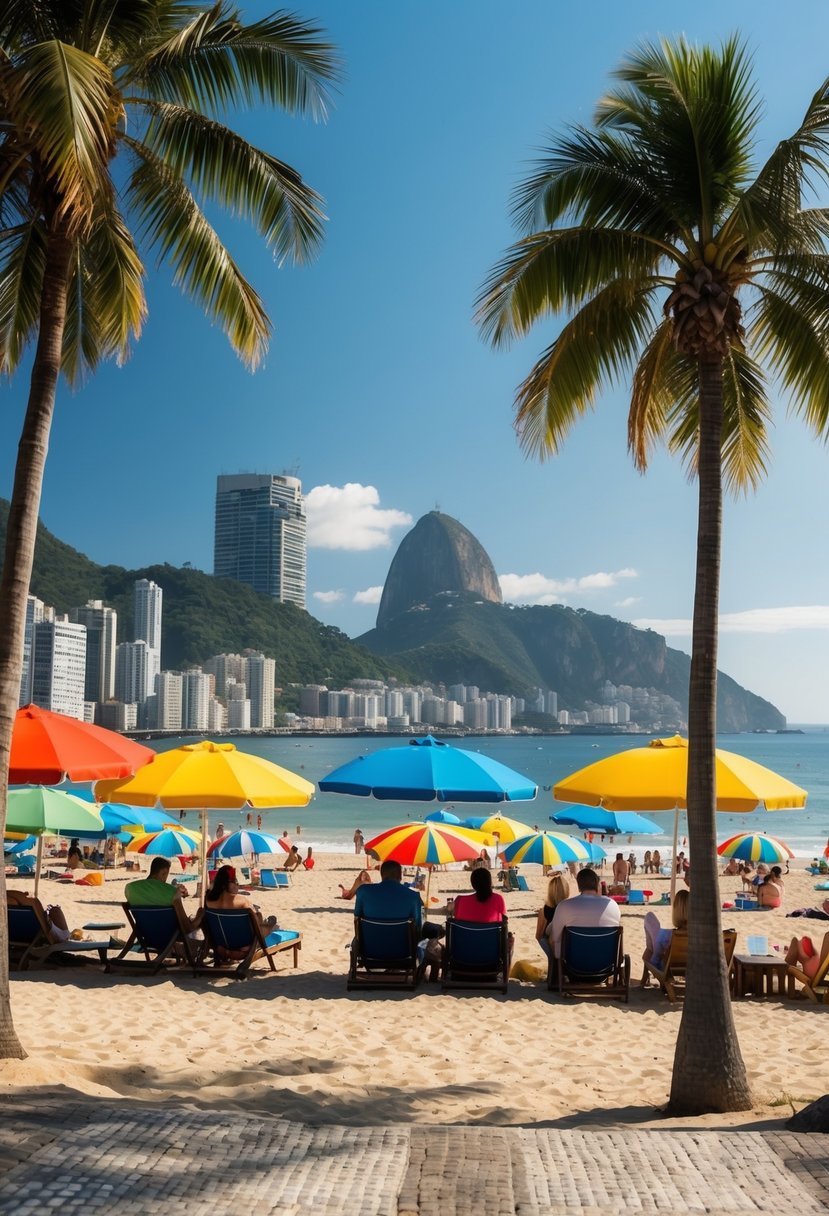Rio de Janeiro Aesthetic: Exploring the Vibrant Culture and Scenic Beauty
Rio de Janeiro is known for its vibrant culture, stunning landscapes, and lively atmosphere. The Rio de Janeiro aesthetic captures the essence of this city through colorful visuals, rich traditions, and a summer vibe that invites exploration. From the iconic beaches of Copacabana and Ipanema to the lush greenery of Tijuca National Park, the aesthetic reflects a mix of natural beauty and urban life.

As people explore this aesthetic on platforms like Pinterest, they find inspiration in decorations, fashion, and photography that showcase the spirit of Rio. Bright colors, lively patterns, and imagery of samba dancing and carnival celebrations are at the heart of this aesthetic. These elements not only highlight Rio’s natural wonders but also its unique cultural experiences.
Through the lens of the Rio de Janeiro aesthetic, one can appreciate the city’s charm and allure. Whether seeking inspiration for travel or simply enjoying the beauty of this location, the aesthetic offers a window into a city that is both captivating and inviting.
Rio de Janeiro: The Heart of Brazil

Rio de Janeiro is often called the “Marvelous City” and embodies the vibrant spirit of Brazilian culture. Known for its breathtaking landscapes, it sits nestled between the Atlantic Ocean and dramatic mountains.
The city’s energy is felt in its lively streets, where samba music fills the air. Carioca refers to people born in Rio and represents the city’s unique identity. They celebrate life through music, dance, and community.
Key landmarks such as Christ the Redeemer and Sugarloaf Mountain are more than just tourist spots; they are symbols of Rio’s soul. Tourists visit Copacabana and Ipanema beaches to experience the local culture firsthand.
Rio hosts renowned festivals like Carnival, showcasing its rich traditions. During this time, vibrant costumes and rhythmic parades celebrate the city’s history and diversity.
People flock to Tijuca National Park, a lush oasis within the urban landscape. It contrasts the buzz of city life with serene nature and offers a glimpse of Brazil’s biodiversity.
In this city, every corner reveals elements of Brazilian culture. From street art to culinary delights, Rio de Janeiro continuously captivates those who explore its heart.
Exploring the Aesthetic of a Cidade Maravilhosa

Rio de Janeiro, known as the “Cidade Maravilhosa,” offers a stunning aesthetic that captivates travelers and photographers alike. The city’s beautiful views include the iconic Sugarloaf Mountain and the panoramic vistas from Christ the Redeemer.
The vibrant culture is reflected in the colorful streets, lively festivals, and unique architecture. Street art plays a significant role in the urban landscape, showcasing local talent and adding to the city’s charm.
For those interested in photography, Rio provides picturesque settings. From sunny beaches like Copacabana and Ipanema to lush parks such as the Botanical Garden, each location offers countless photo opportunities.
Travel aesthetics thrive in Rio. Visitors can immerse themselves in the local culture by exploring markets, trying traditional foods, and enjoying samba music. The blend of nature and urban life creates a dynamic environment that is both inspiring and relaxing.
Key Elements of Rio’s Aesthetic:
- Nature: Beaches, mountains, and lush greenery.
- Culture: Music, dance, and vibrant street art.
- Architecture: Colonial buildings alongside modern designs.
- Lifestyle: A laid-back approach to life that embraces joy and celebration.
These elements come together to form an aesthetic that is both distinct and inviting, making Rio de Janeiro a must-visit destination.
Iconic Landscapes and Cityscapes

Rio de Janeiro is famous for its stunning landscapes that blend mountains, beaches, and urban life. The backdrop of the city is shaped by its unique geography.
Key Features:
- Mountains: The Sugarloaf Mountain and Corcovado are iconic. They provide breathtaking views of Rio.
- Beaches: Copacabana and Ipanema are two of the most recognized beaches. Their golden sands attract locals and tourists alike.
The coastline creates a striking contrast with the urban skyline. This mix of nature and city life is captivating.
Landmarks Include:
- Christ the Redeemer: This statue stands high atop Corcovado Mountain. It is a symbol of the city and offers panoramic views.
- Botafogo Bay: The bay is surrounded by mountains, making it a picturesque spot for photos.
The vibrant neighborhoods, like Santa Teresa, show the city’s cultural richness. Colorful houses and narrow streets add charm to the cityscape.
In Rio, every corner presents a chance to capture beauty. The combination of its landscapes and architecture makes it a top destination for photographers and travelers.
Architectural Triumphs

Rio de Janeiro is known for its stunning architecture that blends modern design with historical significance. This city showcases a variety of styles, including colonial, art deco, and modernist influences.
One of the most iconic structures is Christ the Redeemer, standing 38 meters tall atop Corcovado Mountain. This statue is the largest art deco statue in the world and is a recognized symbol of Brazil.
Another significant achievement is the Museum of Tomorrow. Designed by Santiago Calatrava, it represents the fusion of science and sustainability. Its innovative structure complements the city’s natural landscape.
Rio also boasts a rich collection of colonial buildings. The Teatro Municipal is a prime example, featuring stunning architecture and intricate details, reflecting the cultural history of the city.
Sustainable design plays a key role in Rio’s contemporary architecture. Projects like the RB12 by Triptyque highlight the city’s focus on environmental responsibility. These designs emphasize harmony between urban spaces and nature.
As UNESCO’s World Capital of Architecture in 2020, Rio de Janeiro continues to embrace modern innovations while preserving its cultural heritage. The city’s architectural landscape remains a testament to its evolving identity and artistic vision.
The Cultural Tapestry of Rio de Janeiro

Rio de Janeiro is a vibrant city full of cultural richness. It blends music, art, and traditions from various influences, creating a unique atmosphere.
Music and Dance
Samba is a key element of Rio’s culture. It reflects the spirit of the people and is celebrated during Carnival. This annual festival showcases colorful parades and energetic performances.
Art and History
The city is home to many historical sites, such as the Christ the Redeemer statue and the Historic Center. These landmarks tell the story of Brazil’s past and its colonial roots.
Festivals
Events like Rock in Rio attract international artists and thousands of fans. This music festival highlights Rio’s role in global culture and showcases diverse music genres.
Cuisine
Food is another essential part of Rio’s cultural tapestry. Dishes such as feijoada and street snacks like caldo de cana reflect the city’s culinary traditions.
Community and Heritage
Local communities contribute to Rio’s culture through their customs. The Rio Heritage Institute recognizes these elements, noting their impact on the city’s identity.
Rio de Janeiro stands as a cultural powerhouse. Its blend of experiences creates a lively environment, drawing visitors from around the world to explore its rich heritage.
Carnival: A Kaleidoscope of Color and Energy

Rio de Janeiro’s Carnival is one of the world’s most famous festivals. This vibrant celebration showcases Brazilian culture through spectacular parades, lively music, and dazzling costumes.
During Carnival, the streets come alive with excitement. People gather to enjoy the samba, a dance full of rhythm and passion. The bright colors of costumes, especially reds and yellows, symbolize the energy of the city.
Key Features of Carnival:
- Samba Parades: These are the heart of the celebration. Dancers in elaborate costumes perform intricate routines, captivating audiences.
- Colorful Costumes: Each outfit is designed to reflect creativity and tradition, with feathers and sequins that shine in the sunlight.
- Community Spirit: Carnival is not just a festival; it brings people together, fostering unity among participants and spectators alike.
The atmosphere in Rio during Carnival is electric. Music fills the air, and the energy is contagious. From the Sambadrome to the streets, people dance and celebrate, making it a unique experience.
As the largest festival in Brazil, Carnival demonstrates the country’s rich cultural heritage. It is a true reflection of Rio de Janeiro’s vibrant aesthetic and passionate spirit.
Music and Dance: The Rhythms That Define a City

Rio de Janeiro is alive with music and dance that reflect its culture and energy. Samba is the most famous genre, known for its lively beats and dance moves. It is a vital part of celebrations, especially during Carnival.
Samba’s roots come from African rhythms brought by migrants. This style evolved in Rio, giving rise to Samba Carioca, which is performed in many neighborhoods. The samba schools play a key role. They train dancers and musicians for competitions and parades.
In addition to samba, other styles like bossa nova and forró also thrive. Bossa nova blends samba with jazz, offering a softer sound. Forró, a lively dance from the Northeast, is popular in local festivities.
Rio’s music scene includes live performances in clubs and street festivals. Musicians often gather in parks or beach areas, inviting everyone to join in. This creates an inclusive atmosphere where dance becomes a form of expression.
Festivals contribute to the vibrant aesthetic of Rio. Events like the Rio Carnival unite people through music and dance. These gatherings showcase the city’s spirit, celebrating tradition and creativity.
The rhythms of Rio de Janeiro illustrate the heart of its culture. Music and dance are not just entertainment; they are a way for people to connect and celebrate their heritage.
Cuisine: A Melting Pot of Flavors

Rio de Janeiro’s cuisine offers a vibrant mix of tastes and traditions. This city is known for its rich culinary diversity, influenced by African, European, and Indigenous cultures.
Many dishes showcase these influences. One of the most famous is feijoada, a black bean stew with various meats. It is often served with rice, collard greens, and orange slices, bringing together many flavors in one meal.
Street food also plays a key role in Rio’s food culture. Popular options include:
- Pão de Queijo: Cheesy bread balls that are light and fluffy.
- Coxinha: A savory pastry filled with shredded chicken.
Culinary events in Rio highlight the city’s food scene. One notable event is Comida di Buteco, where local bars compete to present the best snacks, known as petiscos.
Rio’s restaurants range from upscale dining to casual eateries, ensuring there is something for everyone. Each place offers its unique twist on traditional dishes, keeping the culinary scene fresh.
The city’s food is not just about sustenance; it reflects its diverse culture and community spirit. Each bite tells the story of Rio’s history and heritage.
Travel Tips for Enjoying Rio de Janeiro

Visiting Rio de Janeiro can be a memorable experience. Here are some essential tips to help travelers enjoy their time in this vibrant city.
Best Time to Visit:
The ideal months are from December to March. The weather is warm and perfect for beach outings.
Safety First:
Stay aware of your surroundings, especially in crowded areas. Avoid empty streets at night.
Transportation:
Use reliable transport options like registered taxis or rideshare apps. Public transport is good but can be crowded.
Local Culture:
Experience samba, which originated in Rio. Many places offer shows or classes to learn basic moves.
Food and Drink:
Try local street food like pão de queijo and açaí. Stay hydrated and enjoy fresh coconut water.
Beach Etiquette:
Beach life is central in Rio. Visit popular beaches like Copacabana and Ipanema, but respect local customs, such as not taking up too much space.
Explore Nature:
Take time to enjoy the lush landscapes. Visit Sugarloaf Mountain or hike in Tijuca National Park for stunning views.
Nightlife:
Discover Rio’s vibrant nightlife. Popular spots feature samba music and cocktails. Stay within well-lit and crowded areas.
Keeping these tips in mind can help travelers fully enjoy the stunning sights and rich culture of Rio de Janeiro.
Best Time to Visit: Embracing Rio’s Seasons

Rio de Janeiro boasts a diverse climate, influenced by its tropical location. The best time to experience its beauty depends on the visitor’s preferences.
Summer (December to March)
- Weather: Warm and sunny
- Crowds: High, especially during Carnaval
- Rainfall: Possible heavy evening storms
This season attracts many tourists looking for beach fun and vibrant festivities.
Autumn (April to June)
- Weather: Pleasant and mild
- Crowds: Fewer people
- Prices: Lower travel costs
Autumn offers a quieter experience, perfect for those who want to explore without large crowds.
Winter (June to September)
- Weather: Sunny, warm, and dry
- Crowds: Also fewer tourists
- Activities: Great for outdoor adventures
Winter is ideal for visitors who enjoy hiking and sightseeing.
Spring (September to November)
- Weather: Warm with occasional rain
- Crowds: Moderate
- Events: Various local festivals
Spring is a good time for those who want a mix of activity and relaxation.
Choosing the right season helps visitors fully enjoy Rio’s vibrant culture and stunning landscapes.
Navigating the City: Transportation Do’s and Don’ts

Getting around Rio de Janeiro requires some knowledge of its transportation options. Here are key do’s and don’ts to remember.
Do’s:
- Use Public Transportation: The metro is safe and convenient, connecting major areas. Combining it with buses or surface metros can help reach more places.
- Consider Bike Sharing: The Bike Itaú service has over 400 stations. It’s a great way to explore the city at your own pace.
- Take a Cable Car: Enjoy stunning views by taking the cable car to Sugarloaf Mountain. Sunset views from here are breathtaking.
- Be Aware of Timing: For popular spots like Lapa, head out early in the evening to avoid long lines.
Don’ts:
- Avoid Unofficial Cabs: Stick to licensed taxis or rideshare apps for safety and fairness in pricing.
- Don’t Ignore Safety: Stay alert, especially in crowded areas. Keep personal belongings secure and avoid displaying valuables.
- Never Overestimate the Metro: While the metro is efficient, it doesn’t cover all areas. Plan other transport methods for hard-to-reach spots.
- Don’t Travel Late Alone: If traveling at night, choose busy routes and consider organizing transport ahead of time.
Safety and Etiquette: Respectful and Informed Travel

Travelers to Rio de Janeiro should prioritize safety and respect for local customs. The city has a lively atmosphere but also areas that may pose risks.
Key Safety Tips:
- Stay Informed: Always check local safety advisories before venturing out.
- Avoid Certain Areas: Regions like Rocinha and Vila Mimosa are known for higher crime rates.
- Be Aware: Keep an eye on surroundings, especially in crowded places.
Social Etiquette:
- Respect Local Cultures: Rio de Janeiro is a multicultural city. Acknowledging and respecting its diversity enhances the travel experience.
- Dress Modestly: When visiting religious sites or less touristy neighborhoods, modest attire is appreciated.
- Use Caution with Valuables: Avoid displaying expensive items like jewelry or smartphones in public.
Transportation Tips:
- Public Transport: Always use registered taxis or rideshare apps to ensure safer travels.
- Travel in Groups: When possible, move around with friends or fellow travelers, especially at night.
By keeping safety and etiquette in mind, travelers can enjoy the rich beauty and culture of Rio de Janeiro while minimizing risks.
Conclusion: The Everlasting Allure of Rio de Janeiro

Rio de Janeiro captivates with its stunning scenery and vibrant culture. The city’s famous beaches, like Copacabana and Ipanema, showcase the Brazilian aesthetic. Lush mountains and urban settings blend beautifully.
The Christ the Redeemer statue stands tall, symbolizing both faith and art. Visitors admire its grandeur, which adds to Rio’s iconic skyline. Colorful street art enhances the urban vibe, showcasing local talent.
The Cariocas, or locals, bring the city to life. Their energy and passion for samba create an inviting atmosphere. Events like the Carnival reflect Brazil’s rich traditions and lively spirit.
Nature lovers find paradise in places like Tijuca National Park. Here, they enjoy hiking trails and breathtaking views. The lush landscapes highlight the Travel Aesthetic associated with exploration.
Rio’s unique combination of history and modernity makes it unforgettable. From the historical architecture to the festive beaches, Rio de Janeiro remains a top destination for travelers. Each visitor leaves with memories shaped by the city’s enchanting allure.

![Is Oakland Airport Big [Disclosed]](https://howtravelplan.com/wp-content/uploads/2024/06/is-oakland-airport-big-disclosed_3717-768x531.jpg)


![Why Does Credit One Bank Keep Calling Me [Discovered]](https://howtravelplan.com/wp-content/uploads/2024/06/why-does-credit-one-bank-keep-calling-me-discovered_3928-768x531.jpg)
![Why Is Lake Elsinore So Cheap [Clarified]](https://howtravelplan.com/wp-content/uploads/2024/06/why-is-lake-elsinore-so-cheap-clarified_3912-768x531.jpg)
![Is Heathrow Airport Bigger Than Dublin Airport [Disclosed]](https://howtravelplan.com/wp-content/uploads/2024/06/is-heathrow-airport-bigger-than-dublin-airport-disclosed_3666-768x531.jpg)